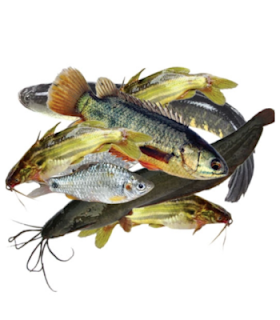Bangladesh is renowned for its vast and diverse aquatic biodiversity, thanks to its extensive network of rivers, floodplains, coastal waters, and marine habitats. The country is home to a rich variety of fish species, making the fisheries sector a vital part of its economy and culture. Fish contributes significantly to the national GDP, employment, and food security, with millions of people relying on it for sustenance and livelihood. Additionally, fish is a staple in the Bangladeshi diet, featuring prominently in traditional cuisine and playing a crucial role in the nation’s culinary heritage.
How Many Fish Species Are There in Bangladesh?
Bangladesh boasts an impressive array of fish species, spanning freshwater, brackish water, and marine ecosystems. According to research, Bangladesh has over 800 species of fish, including 260 freshwater species and 475 marine species.
Breakdown of Fish Species:
Native Species: Includes a variety of indigenous fish found naturally in rivers, lakes, and floodplains.
Exotic Species: Introduced fish species such as Tilapia and Pangas, which have been widely adopted in aquaculture due to their high yield and market demand.
Classification of Fish Based on Habitat:
Riverine Fish: Found in major rivers such as the Padma, Meghna, and Jamuna.
Estuarine Fish: Found in coastal and brackish water areas like the Sundarbans.
Marine Fish: Inhabit the Bay of Bengal and the deep sea.
Floodplain Fish: Thrive in seasonal water bodies like beels, haors, and baors.
Reservoir Fish: Found in man-made reservoirs and lakes.
Types of Water Bodies and Fish Found in Bangladesh
Freshwater Fish (Rivers, Ponds, Lakes, Beels, Haors, Baors)
Freshwater fish are abundant in Bangladesh, with major rivers and water bodies supporting a rich diversity of species. Popular freshwater fish include:
Carps: Rui (Labeo rohita), Katla (Catla catla), Mrigal (Cirrhinus mrigala)
Catfish: Pabda (Ompok pabda), Shing (Heteropneustes fossilis), Magur (Clarias batrachus)
Small Indigenous Species (SIS): Mola (Amblypharyngodon mola), Darkina (Esomus danricus)
Brackish Water Fish (Estuaries, Coastal Rivers, Mangroves)
Brackish water fish are found in transitional zones between freshwater and saltwater. Notable species include:
Bhetki (Barramundi) (Lates calcarifer)
Chingri (Tiger Prawn) (Penaeus monodon)
Parse (Liza parsia)
Marine Fish (Bay of Bengal, Deep Sea, Coastal Areas)
The Bay of Bengal is home to numerous commercially important fish species, including:
Hilsa (Ilish) (Tenualosa ilisha) – the national fish of Bangladesh
Pomfret (Pampus spp.)
Mackerel (Rastrelliger spp.)
Tuna (Thunnus spp.)
Aquaculture and Farmed Fish
Aquaculture has grown significantly, contributing to increased fish production. Common farmed fish include:
Tilapia (Oreochromis niloticus)
Pangas (Pangasius spp.)
Koi (Anabas testudineus)
Challenges in the Fisheries Sector of Bangladesh
Despite its richness in fish biodiversity, Bangladesh faces several challenges in the fisheries sector:
Overfishing and Depletion of Natural Fish Stocks
Unregulated fishing has led to the decline of many native fish populations, especially in rivers and coastal areas.
Water Pollution and Environmental Degradation
Industrial waste, agricultural runoff, and plastic pollution are threatening aquatic ecosystems, affecting fish health and production.
Climate Change Impact
Rising sea levels, erratic rainfall, and frequent cyclones are disrupting fish habitats, particularly in coastal and riverine areas.
Illegal Fishing Methods
Use of fine-mesh nets, dynamite fishing, and harmful chemicals are causing significant damage to fish populations.
Limited Technological Advancements in Fish Farming
Many fish farmers lack access to modern technology, quality fish feed, and proper disease management practices.
Global Ranking of Bangladesh in Fish Production
Bangladesh is one of the top fish-producing countries in the world. According to the Food and Agriculture Organization (FAO):
Bangladesh ranks 3rd in inland fish production globally.
Hilsa production in Bangladesh is the highest in the world.
The fisheries sector contributes about 3.57% to the national GDP.
Over 12% of Bangladesh’s population is directly or indirectly dependent on the fisheries industry.
Comparison with Other Top Fish-Producing Countries:
China – The world’s largest fish producer, contributing over 35% of global fish production.
India – A major producer of inland and marine fish.
Indonesia – Known for its extensive marine fisheries.
Bangladesh – Rapidly growing in aquaculture and Hilsa production.
Government Initiatives and Sustainable Solutions
To support sustainable fisheries, the government of Bangladesh has implemented several measures:
Policies and Regulations for Sustainable Fisheries Management
The Fisheries Act (1950) – Regulates fishing practices and conservation efforts.
The Hilsa Conservation Program – Includes seasonal fishing bans to protect breeding stocks.
Role of Bangladesh Fisheries Research Institute (BFRI)
Conducts research on fish breeding, conservation, and disease control.
Develops advanced aquaculture techniques to increase productivity.
Promotion of Eco-Friendly Fish Farming Practices
Encouraging integrated fish farming methods such as rice-fish culture.
Training farmers on the use of bio-secure hatcheries and organic fish feed.
Future Potential and Strategies for Improving Fish Production
Expanding marine fisheries and deep-sea fishing initiatives.
Strengthening climate resilience in the fisheries sector.
Increasing public and private sector investment in aquaculture technology.
Conclusion
Bangladesh's fisheries sector is a cornerstone of its economy, food security, and culture. With over 800 species of fish, diverse aquatic habitats, and a strong tradition of fishing, the country has immense potential for growth. However, challenges such as overfishing, climate change, and pollution must be addressed through sustainable practices and government initiatives.



.jpg)

.jpg)








.jpg)

.jpg)
.jpg)
.jpg)
.jpg)
.jpg)
0 Comments